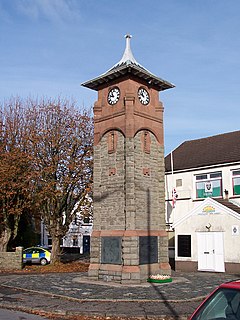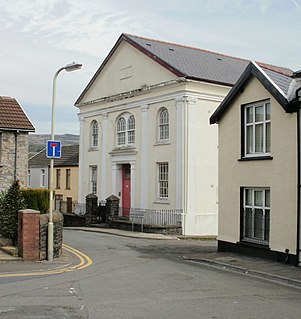
Aberdare is a town in the Cynon Valley area of Rhondda Cynon Taf, Wales, at the confluence of the Rivers Dare (Dâr) and Cynon. Aberdare has a population of 39,550. Aberdare is 4 miles (6 km) south-west of Merthyr Tydfil, 20 miles (32 km) north-west of Cardiff and 22 miles (35 km) east-north-east of Swansea. During the 19th century it became a thriving industrial settlement, which was also notable for the vitality of its cultural life and as an important publishing centre.

Hirwaun is a village and community at the north end of the Cynon Valley in the County Borough of Rhondda Cynon Taf, South Wales. It is 4 miles (6 km) NW of the town of Aberdare, and comes under the Aberdare post town. At the 2001 census, Hirwaun had a population of 4,851. increasing at the 2011 census to 4,990. The village is on the Heads of the Valleys Road and at the southern edge of the Brecon Beacons National Park.

Abernant is a small village north-east of the town of Aberdare, Rhondda Cynon Taf, Wales. Like many in the South Wales Valleys, it was once a coal-mining village.

Trecynon is a village near Aberdare situated in the Cynon Valley, in Rhondda Cynon Taf, Wales. It dates from the early nineteenth century and its developed as a result of the opening of the Aberdare Ironworks at Llwydcoed in 1800.
Thomas Price was a leading figure in the political and religious life of Victorian Wales and minister of Calfaria Baptist Chapel, Aberdare.

Siloa, Aberdare was the largest of the Welsh Independent, or Congregationalist, chapels in Aberdare. Services are held in the Welsh language. Established in 1844, Siloa is one of the few Welsh language chapels in the locality to remain open today. Siloa was notable for its long-serving ministers and in over a century there were only three pastorates, namely those of David Price (1843–78), D. Silyn Evans (1880–1930) and R. Ifor Parry (1933–64).

Bethel, Abernant is a Baptist Chapel at Abernant in the Aberdare Valley in Wales and one of the few nonconformist chapels in the area that remained open into the twenty-first century.
Heolyfelin Chapel, Trecynon, Aberdare was a Welsh Baptist chapel established in 1855. Services were held in the Welsh language. The building seated 800. By December 2015 the chapel had closed and was for sale.
Gwawr, Aberaman was a Baptist chapel in Regent Street, Aberaman, near Aberdare, South Wales, formed as a branch of Calfaria, Aberdare
Seion, Cwmaman is a Welsh Baptist church, originally established in 1859. The chapel closed in 2013 but the church still meets at another location in the village.
Ynyslwyd Chapel, Aberdare was a Baptist chapel in Sunny Bank Place, located between Aberaman and Aberdare. It was formed as a branch of Calfaria, Aberdare.

Gadlys Chapel was a Baptist chapel in Railway Street, Gadlys, Aberdare, Rhondda Cynon Taf, Wales. It was formed as a branch of Calfaria, Aberdare.
Ebenezer, Trecynon is an Independent (Congregationalist) chapel in Ebenezer Street, Trecynon, Aberdare, Wales. It was one of the earliest Independent chapels in the Cynon Valley and remained an active place of worship until 2009.

Ramoth, Hirwaun originally a Baptist chapel in Davies Row, Hirwaun, Aberdare, Wales. Services at Ramoth were held in the Welsh language. Following renovation in 1982, the building continues to be used for Christian worship as an Assemblies of God fellowship.
Jerusalem, Penrhiwceiber was a Baptist chapel in Penrhiwceiber, Glamorgan, Wales. Services at Jerusalem were conducted in the Welsh language.

Bethesda, Abercwmboi is a Welsh Baptist church in Abercwmboi near Aberdare. Services continue to be held in the Welsh language.
James Griffiths who served as minister of the Baptist churches at Calfaria, Llanelli and Calfaria, Aberdare.
Bethania, Cwmbach was a Baptist Chapel at Cwmbach in the Aberdare Valley in Wales. Badly damaged by an air raid attack in 1941 it was subsequently restored but closed in the 1980s. Services were held in the Welsh language.
Rhos, Mountain Ash was a Baptist chapel in Mountain Ash, Glamorgan, Wales. Services at Rhos were conducted in the Welsh language.
Soar, Llwydcoed was a Baptist Chapel in Kingsbury Place, Llwydcoed, Aberdare, Glamorgan, Wales. Services at Soar were held in the Welsh language.











